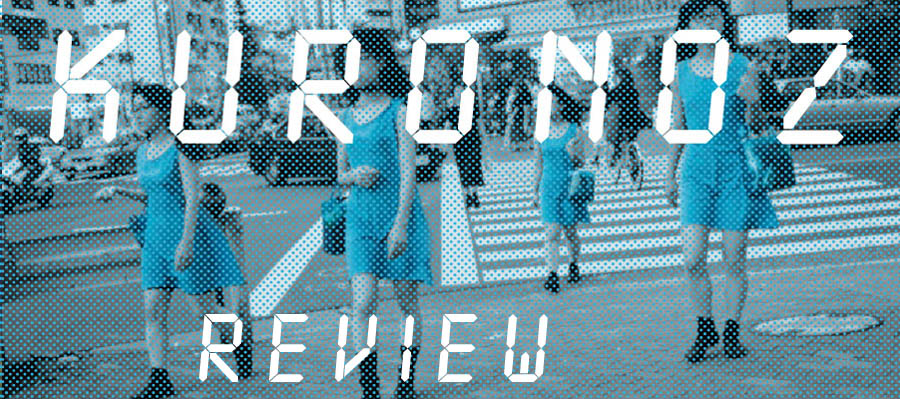

-
ナディア・ローロ「寄って行く?」評 オン☆ステージ新聞 抜粋
-
いつの間にか観客の中にわざとらしいカツラをつけた人が増える。
座ってみていると隣の人が突然セリフをしゃべりはじめる。かと思えばやおら踊り始める。 -
At some time or other, there were people with phony wigs. Among the audience who all sat on the floor, there were people suddenly recited the line. And all the sudden, they started dancing. (Excerpts from review of Nadia Loro’s "Tu montes?" On Stage Paper )

Corpus(身体表現批評誌)4号より抜粋
差別化を笑うアイロニー – 増殖プロジェクト・KURONOZ--
KURONOZのパフォーマンスは、日常の景色を鮮やかに塗り替えながら、人の内面の自由度を強調しているように思える。表層的な、うすっぺらい個性なんて軽く剝して裸にしてしまう強さと、ニヤリとさせるアイロニーを持って、痛快に。
亀田恵子
http://blog.so-net.ne.jp/arts_and_theater_literacy/2007-12-30#more -
Excerpts from Corpus (critique magazine of performing arts) #4
Irony of Sneering off Differentiation 』Multiplying Project – KURONOZ
People differentiate to keep up predominance, to identify who they really are. How painful and futile a thing that is. KURONOZ’s performance vividly changes and peels off the skin from the trend of individualism. Making it naked, with an irony full of sneering.
Keiko Kameda
http://blog.so-net.ne.jp/arts_and_theater_literacy/2008-04-13-3#more 
こぐれ日録vol.523.より抜粋
-
クロノズ「Yes-7% No-91%」。愛知から来たらしい黒野靖子と増殖ダンサーズ5名。黒野靖子が椅子に座って英和辞典(TRENDという現在に使われている用語辞典のようだ)の674ページだかどこかを読み出す。food・・・バイオ野菜とか生命科学関連らしい。英語の発音を聞くとプロだなあと思う。 辞典が「クローン人間」についての解説のところに来る。これが主題なのは、ユニット名からも明らかだし、当日パンフにも「水色のワンピースに黒縁眼鏡、黒い髪、ダンスシューズ姿のメンバー」と黒野さんのクローンを仄めかすものがあった。 が、客席にいた、徳毛さんらポポル・ブフとかセレノグラフィカとかが、この増殖ダンサーズとして、変身(=クローン化)するとは知らず、なかなかのおかしさ。紙袋ががさがさいうのが、英語の発音うまいけどちょっとスノッブやなあという退屈モードをうまくあしらう結果となったところが、一番面白いポイントである。 踊りというよりも、ショーぽい。セレノの阿比留さんは女装には興味がなかったらしいけれど、脇の毛を剃ったりがんばっていた。このバリエーションってやっぱり面白いしやってみたいものである。
小暮宣雄
http://www.arts-calendar.co.jp/KOGURE/04_04/NfG-arts_competition*vol-4.html Excerpts from Arts Calendar/Art's Report site/《KOGURE Journal vol.523.》NfG-arts competition.vol.4
KURONOZ “Yes- 7% No-91%"
A performance from Ms. Kurono, of Aichi, and five multiplying dancers.
Ms. Kurono sat on a chair reading ‘current terms’ out-loud from a Japanese-English dictionary. Her pronunciation of English words was impressive.
When she started reading the section on “genetics and cloning” it became obvious that this would be the theme of the performance; aided by the program that described there would be clones of Ms. Kurono dressed in “blue dress, glasses, wigs and dance shoes”. Kansai-based local dancers such as Ms. Tokumo, Ms. Sumichi and Mr. Abiru - who were sitting down as audience - started taking out blue dresses from paper bags. They changed from their clothes to become clones. It was a surprise because I did not know the local dancers were to become KURUNOZ.
Ms. Kurono’s well spoken English, snobbish attitude and her deliberate pace could have bored the audience, yet the noise of the clones offered a good balance, making the performance more interesting to experience.
Mr. Abiru said later that he was not interested in dressing in women’s clothes, but having shoved his arm and legs into a small dress showed the effort he went to in preparation for the performance.
It was more like show rather than dance. This type of variation on dance-performance is interesting and I would like to see more of it.
Ms. Kurono’s well spoken English and snobbish attitude could have made the audience bored, but the noise of the clones making ‘offered good’ balanced out her deliberate pace and gave the performance dynamic, making it interesting to experience.
Mr. Abiru said later that he was not interested in dressing in women’s clothes, but having shoved his arm and legs into a small dress showed the effort he went to in preparation for the performance.
It was more like show rather than dance. This type of variation on dance-performance is interesting and I would like to see more of it.
Nobuo KOGURE


